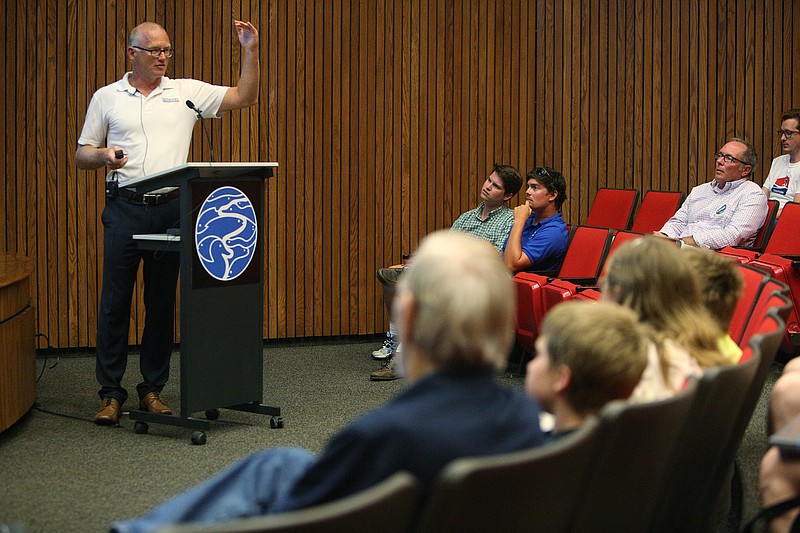A German scientist, professor and world record-holding endurance swimmer spoke Thursday in Chattanooga, as he continues an effort to swim and survey the waters of the entire length of the Tennessee River.
Andreas Fath, a professor of chemistry at Germany's Furtwangen University, hopes to raise awareness of how important water quality is by collecting data as he swims. He's also hoping to break another world record.
Fath plans to complete the entire 652-mile swim within 31 days. At the end of each day, Fath will get out of the water in a different city along the river. He and his team then conduct several water quality tests based on parameters collected during that day's swim, and some of the samples are sent to the university in Germany for further testing.
Today, Fath will swim into downtown Chattanooga, nearly 182 miles downstream from Knoxville, Tenn., where he began on July 27. He has 470 miles to swim before reaching Paducah, Ky., where the river joins the Ohio River. As he swims into Chattanooga, a group from Chattanooga Open Water Swimmers will join him for the last two miles of swimming before he gets out at the Chattanooga Pier at around 1:30 p.m.
Swimming is not all that consumes Fath's day. On Thursday evening, he held a presentation in the Tennessee Aquarium's River Journey Auditorium. There, he explained how he collects data and shared results from his 2014 "swim for science" in the European Rhine River. He completed that 765-mile-long swim in 28 days.
A day for Fath and his team involves waking up at 6:15 a.m., having a quick breakfast and starting the trip back to wherever they left off the day before. He swims for eight to six hours each day, taking breaks every 30 minutes to drink water and cool off with ice (he wears a wet suit and the warm water can cause him to heat up quickly).
He takes a break between 1 and 2 p.m. for lunch and a nap, he said. And when he's done swimming, he jumps in the shower, eats dinner and is in bed by 10 p.m. He said he and his team usually stay at campsites, but while he's in Chattanooga, he is staying with a friend.
"I'll get to enjoy a king-sized bed for a change," he said with a laugh.
But Fath doesn't necessarily have to swim the entire river to collect the data and conduct the tests. He said he could be on a boat doing the same thing, but it wouldn't attract as much attention, which is his goal - to raise awareness.
"If I wasn't swimming, you all wouldn't be here talking to me," Fath said, referring to the media and public waiting to listen to his presentation.
So far, Fath said, the analysis they've been able to complete of the river's water quality doesn't show any real concerns, such as nitrates, phosphates and other pollutants. What he is mainly concerned about is the level of microplastics - what plastic leaves behind once it's been worn down by natural elements - and pharmaceuticals, as well as heavy metals and flourinated chemicals - the stuff that is often found in fast-food packaging and non-stick cookware because of its ability to resist grease and stains.
Those analyses, which include up to 600 chemicals, will be evaluated four to 10 weeks after the swim has been completed and will be available for the public to review on the TenneSwim website, en.rheines-wasser.eu.
"This project will be the most extensive interdisciplinary water quality survey ever conducted of North America's most biologically diverse river," according to a release from the Tennessee Aquarium.
Fath said he chose to swim the Tennessee River mostly because of his friend, Martin Knoll, a professor of geology at The University of the South in Sewanee, Tenn. Knoll, also German, said he reached out to Fath after hearing about his study of the Rhine River.
"We simultaneously thought of the Tennessee River," Knoll said, adding that the two rivers share similar qualities, although the Rhine's currents are stronger.
Anna George, vice president of science education for the Tennessee Aquarium, said the study of the Tennessee River will shed more light on pollution in American rivers.
"We know a lot about pollution in the ocean, but there isn't much on rivers," she said, which is important because what is in the rivers will eventually end up in the ocean.
"This can help us find out how far inland certain pollutants are coming from," she said.
The Tennessee River's water quality has greatly improved over the past 40 years. The Industrial Revolution left many of the country's waterways heavily polluted, and many were not safe to swim. The Tennessee River was no exception, as many factories dotted its edge.
Then in 1972, the Clean Water Act was passed, setting wastewater standards for industry and paving the way for the country's waterways to repair the damage.
George said that while much of the pollutants that cause the waters to be unsafe to swim have steadily decreased, mercury levels in fish have continued to increase due to the coal-fired plants needed to produce electricity. That is why there are still precautionary advisories against eating certain fish caught in the river, especially for children and pregnant or nursing women, she said.
"The Clean Water Act has helped industrial pollution very much," George said, but added that other pollutants, like plastic, pharmaceuticals and coal-powered energy, still need to be remedied.
Pollutants need to be addressed both on a large and small scale, she said.
"You know, how can we fix our daily activities, as well as our industrial activities," she said.
Contact staff writer Rosana Hughes at rhughes@timesfree press.com or 423-757-6327. Follow her on Twitter @HughesRosana.
BY THE NUMBERS
652 miles: The length of the Tennessee River230: Species of fish in the river150: Species of turtles in the river100: Species of mussels in the riverSource: TenneSwim
THE ROUTE
Stage 1: July 27, Ijams Nature Center, KnoxvilleStage 2: Choto BendStage 3: LoudonStage 4: KingstonStage 5: Watts Bar LakeStage 6: DecaturStage 7: DaytonStage 8: LakesiteStage 9: Today, ChattanoogaStage 10: Tennessee River GorgeStage 11: Nickajack LakeStage 12: Stevenson, Ala.Stage 13: Scottsboro, Ala.Stage 14: Guntersville, Ala./Marshall County ParkStage 15: Flint River confluence near Huntsville, Ala.Stage 16: Cotaco Creek confluence near Redstone ArsenalStage 17: Near Brown’s Ferry Nuclear PlantStage 18: Wheeler Dam Village, Ala.Stage 19: Florence, Ala.Stage 20: Waterloo, Ala.Stage 21: Pickwick Dam, Tenn.Stage 22: Savannah, Tenn.Stage 23: Swallow Bluff, Tenn.Stage 24: Cedar Bluff Rd – Jones Landing, Tenn.Stage 25: North of Parsons, Tenn.Stage 26: Duck River confluenceStage 27: North of Nat. Bed. Forrest Park – Doverdale Hollow RoadStage 28: Paris Landing State Park, Tenn.Stage 29: Aurora, Ky.Stage 30: Kentucky Dam Village, Ky.Stage 31: Paducah, Ky.
TIPS FOR CLEANER WATERS
Here are five ways you can safeguard the rivers, lakes and streams near you:› Don’t flush meds: Any pharmaceuticals you flush down the toilet or pour down the sink inevitably end up in a body of water. As part of its National Take-Back Initiative, the U.S. Drug Enforcement Administration has authorized thousands of collectors who can safely dispose of unused medication for you. Find a collector near you by calling 1-800-882-9539.› Skip the straw: Plastic is the most prevalent type of debris in aquatic environments, and single use plastics, such as drinking straws, are a major source of this pollution. Over time, these items break down but don’t fully biodegrade, creating fragments (microplastics) that can be consumed by animals, impacting their ability to feed as well as contaminating the seafood people enjoy. Instead of a plastic straw, use an alternative, reusable sipping device made from paper, metal, glass or even bamboo.› Fertilize with care: Using too much fertilizer can affect your plants’ ability to absorb water and can contaminate nearby streams when the excess is carried away by stormwater run-off. To prevent this, follow the label instructions carefully to mix the fertilizer accurately and only use it during the appropriate time of year.› Don’t go down the drain: Storm drains are like superhighways that transport chemicals,unfiltered and untreated, into local waterways. Do a web search to find local hazardous waste disposal sites near you rather than risk a fine or damage to a nearby stream.› Jump in! Stricter government regulations have made many waterways safe for human recreation, but that wasn’t always the case. You can now fish, swim, paddle or otherwise enjoy many of the rivers, lakes and streams near you because of the clean water regulations of the past 45 years. By making use of these waterways, you’ll show legislators that communities value the cleaner water these laws made possible.Source: TenneSwim

